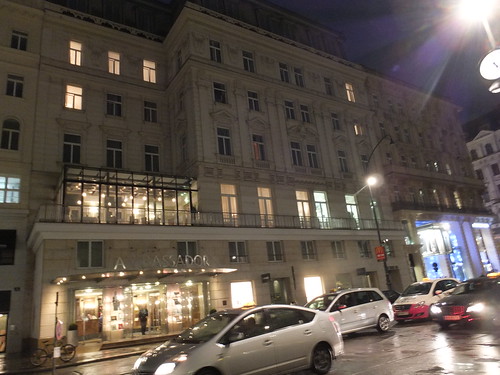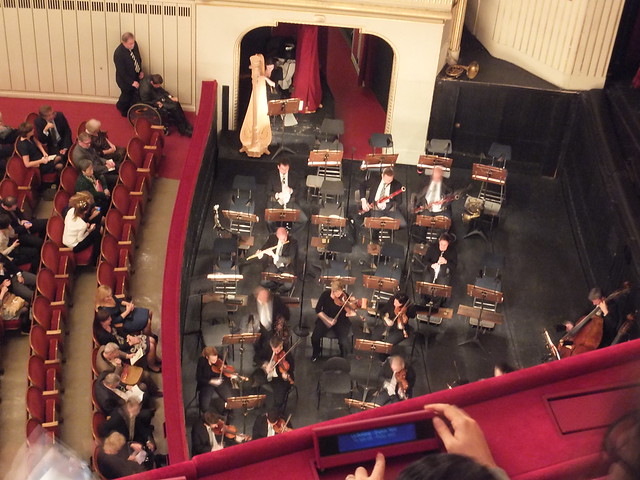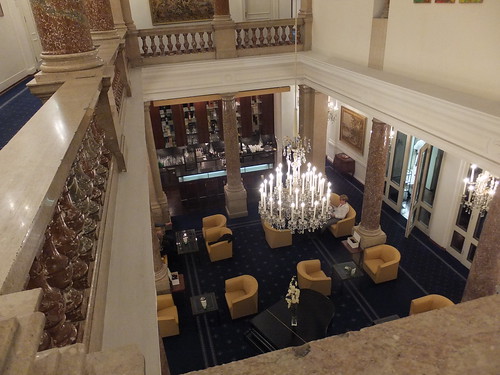Events of Friday, 7th November 2014
We flew to Vienna by British Airways flight BA700 from Heathrow Terminal 3. The aircraft was an A320 and the flight took around two hours. We were taken into the city by a very smart black saloon. I noticed that it was a hybrid because I was fascinated by the dashboard display showing whether we were running in normal mode, ECO mode or battery charging mode. Every time the driver touched the brakes, regenerative braking put charge into the battery. I think it was a Lexus, but I can't be sure.
On the way to the city, we passed a large oil refinery and a power station and then spent some time threading our way around the narrow, convoluted streets of the old part of the city to arrive at our hotel, the Ambassador, set in the Neuer Markt and overlooking the fountain by Rafael Donner. The Hotel had allocated two interconnected Apartments for us, which gave us lots of space.
 The Ambassador Hotel at night.
The Ambassador Hotel at night.
Rita is an opera enthusiast and was keen to see a performance at the world-famous Wienner Staatsoper, (the Vienna State Opera House). Ballet and Opera alternate and, amazingly, the programme changes virtually every day, presenting major logistical problems. I believe six or seven large lorries arrive each day with scenery for the next performance and the costume department keep track of 150,000 costumes. On our first evening in Vienna, the performance was to be the opera 'La Boheme' by Puccini. When we enquired at our hotel, we were told that the opera was sold out that evening but that there was a possibility of obtaining a ticket at the Opera House.
Told that it would only take a few minutes to walk to the opera house, we obtained directions, borrowed an umbrella (for the evening had turned quite wet) and set off. We located the huge building without too much difficulty and wandered amongst the good-natured crowds assembling outside the building. With around 90 minutes to go before the performance, the doors remained firmly locked. In discussion with other tourists, we gathered that there was a standing area where tickets cannot be pre-booked but which are sold, first come, first served about an hour before the start of the performance. We decided that we'd try this option, although I was worried about Rita having to stand for the length of the performance (about two and a half hours with intervals). Come to that, I was worried about me standing for that length of time.

'Playbill' outside the Opera House (actually a flat-screen display).
When they opened the doors to admit people to the standing area, there was initially a bit of a rush but a queue formed in a long passage inside the opera house. We shuffled along this passage until we reached a small Box Office solely selling tickets for the standing area. We obtained two tickets and moved into the foyer area where stairs led upwards. The opera house seats over 2,200 people and, as you would imagine, ticket prices vary according to location, from around 250 Euros downwards. Our tickets cost 3 Euros, representing excellent value provided you are prepared to stand. People hastened to climb the stairs so as to secure more desirable locations to stand and Rita and I were rather swept along by this, finally arriving at a narrow standing area behind the tiered seating of the uppermost gallery, in an area called in the British theatre "the Gods". There was a separate cloakroom at this level which was rapidly filling with coats and backpacks. I had to surrender the umbrella. It was noticeable that the 'standees' tended to be young or fairly old, informally dressed and included quite a few tourists. Looking towards the 'posh' seats below us, it struck me that the patrons there tended to be middle aged and more formally dressed.
Seating Plan. Click above for the uncropped image.
The standing area is separated from the seating area by a metal handrail with a padded top so at least there's something to lean against. Like all the galleries, the standing area handrail is provided with frequent electronic displays which you can set to present the words being sung in a number of languages. When 'surtitles' started to be provided in operas, there was some criticism from traditionalists but I found the arrangements helpful and unobtrusive.
Although the standing space is unreserved, there is an informal tradition that, once you have found a suitable spot, you can 'reserve' it by marking the section of railing with a scarf or by hanging printed programme notes on the railing. Once having 'claimed' a spot, the opera-goer can go for refreshments or whatever confident that the space will remain unoccupied. I rather liked the courtesy of this system. It was also apparent that standees tend to be enthusiasts, there for the performance rather than 'to be seen'. One lady we talked to attends around ten performances a month in this way. A lady teacher from Finland we'd queued with insisted on fetching refreshments for Rita and myself. All-in-all I found it a very friendly experience.
The performance was due to start at 7.00 p.m. With ten minutes to go, the auditorium rapidly filled up until I couldn't see a spare seat anywhere. The standing area was crowded, too. Our spot was near the stage which is supposed to be good for sound but meant we could only see about half of the stage. At the same time, the large orchestra were assembling in the orchestra pit.
 With a few minutes to go, this was our view of the orchestra pit with the stage on the right. Members of the orchestra were taking their places and by the time the performance started, all the seats in the auditorium were filled. On the right at the bottom of the picture, one of the electronic displays can be seen.
With a few minutes to go, this was our view of the orchestra pit with the stage on the right. Members of the orchestra were taking their places and by the time the performance started, all the seats in the auditorium were filled. On the right at the bottom of the picture, one of the electronic displays can be seen.
We then enjoyed 'La Boheme' performed by world-class musicians and artists.
On the way out, I was able to see more of the elaborate foyers and entrance hall. When the building was opened in 1869, it was not immediately popular with the public. The auditorium and stage were badly damaged at the end of World War II, requiring elaborate reconstruction in a somewhat modernised style. The entrance area remains largely as originally constructed. There's more information in the Wikipedia article here.

Patrons leaving via the impressive entrance hall at the Vienna Opera House.
Rita and I walked back to our hotel. The restaurant had closed, but we were able to enjoy a light meal in the rather grand bar area before retiring for the night.
 The bar area at the Ambassador, viewed from above.
The bar area at the Ambassador, viewed from above.
Related posts on this website
A Weekend in Vienna (Part 2).
A Weekend in Vienna (Part 3).
A Weekend in Vienna (Part 4).
A Weekend in Vienna (Part 5).
Books
[1] 'Imperial Vienna' by Lina Schnorr, published by H.B. Medienvertrieb GesmbH (ISBN: 978-3-9502396-9-0).
[2] 'Vienna: Art and Architecture', by various authors, published by h.f. ullmann (ISBN 978-3-8331-6006-6).
My Pictures
The albums below relate to this post:-
Ambassador Hotel, Wien.
Wien, Austria.
Vienna State Opera.
The collection below includes all the albums on the Vienna trip:-
Austria.
